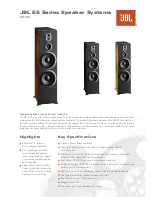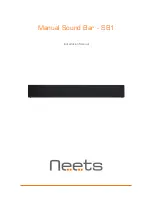
4
17. Damage Requiring Service - Unplug the unit from the outlet and refer servicing to
qualified service personnel under the following conditions:
a.
When the power-supply cord or plug is damaged.
b. If liquid has been spilled, or objects have fallen into the unit.
c
If the unit has been exposed to rain or water.
d. If the unit does not operate normally by following the operating instructions.
Adjust only those controls that are covered by the operating instructions, as an
improper adjustment of other controls may result in damage and will often require
extensive work by a qualified technician to restore the unit to its normal operation.
e. If the unit has been dropped or the cabinet has been damaged.
f.
When the unit exhibits a distinct change in performance--this indicates a need for
service.
18. Replacement Parts - When replacement parts are required, be sure the service technician
has used replacement parts specified by the manufacturer or have the same characteristics
as the original part. Unauthorized substitutions may result in fire, electric shock or other
hazards.
19. Safety Check - Upon completion of any service or repairs to this unit, ask the service
technician to perform safety checks to determine that the unit is in proper operating
condition.
20. Coax Grounding - If an outside cable system is connected to the unit, be sure the cable
system is grounded. U.S.A. models only--Section 810 of the National Electrical Code,
ANSI/NFPA No.70-1981, provides information with respect to proper grounding of the
mount and supporting structure, grounding of the coax to a discharge unit, size of ground-
ing conductors, location of discharge unit, connection to grounding electrodes, and
requirements for the grounding electrode.
21. Lightning - For added protection of this unit during a lightning storm, or when it is left
unattended and unused for long periods of time, unplug it from the wall outlet and discon-
nect the cable system. This will prevent damage to the unit due to lightning and power-
line surges.
FCC & ICES INFORMATION
(U.S.A. and Canadian Models Only)
WARNING - THIS EQUIPMENT HAS BEEN TESTED AND FOUND TO COMPLY WITH
THE LIMITS FOR A CLASS B DIGITAL DEVICE, PURSUANT TO PART 15 OF THE FCC
RULES AND ICES-003 OF INDUSTRY CANADA. THESE LIMITS ARE DESIGNED TO PRO-
VIDE REASONABLE PROTECTION AGAINST HARMFUL INTERFERENCE WHEN THE
EQUIPMENT IS OPERATED IN A RESIDENTIAL INSTALLATION. THIS EQUIPMENT
GENERATES, USES AND CAN RADIATE RADIO FREQUENCY ENERGY AND, IF NOT
INSTALLED AND USED IN ACCORDANCE WITH THE INSTRUCTIONS, MAY CAUSE
HARMFUL INTERFERENCE TO RADIO COMMUNICATIONS. HOWEVER, THERE IS NO
GUARANTEE THAT INTERFERENCE WILL NOT OCCUR IN A PARTICULAR INSTALLA-
TION. IF THIS EQUIPMENT DOES CAUSE HARMFUL INTERFERENCE TO RADIO OR
TELEVISION RECEPTION, WHICH CAN BE DETERMINED BY TURNING THE EQUIP-
MENT OFF AND ON, THE USER IS ENCOURAGED TO TRY TO CORRECT THE INTER-
FERENCE BY ONE OR MORE OF THE FOLLOWING MEASURES:
•
Reorient or relocate the receiving antenna.
•
Increase the separation between the equipment and receiver.
•
Connect the equipment into an outlet on a circuit different from that to which the
receiver is connected.
•
Consult the dealer or an experienced radio/TV technician for help.
Intentional or unintentional changes or modifications not expressly approved by the party
responsible for compliance shall not be made. Any such changes or modifications could void
the user’s authority to operate the equipment. The user may find the following booklet pre-
pared by the Federal Communications Commission helpful: “How to Identify and Resolve
Radio-TV Interference Problems”. This booklet is available from the U.S. Government Printing
Office, Washington, DC 20402, Stock No.004 000 00345 4.
Eng
Содержание LBC 2502/10
Страница 8: ...23 1 2 3 b c a 4 ...



























